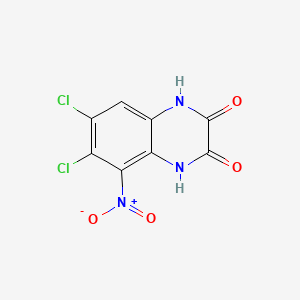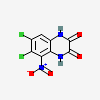Licostinel
PubChem CID
5486198
Molecular Formula
Synonyms
- Licostinel
- 153504-81-5
- 6,7-DICHLORO-5-NITROQUINOXALINE-2,3(1H,4H)-DIONE
- ACEA-1021
- 6,7-dichloro-5-nitro-1,4-dihydroquinoxaline-2,3-dione
Molecular Weight
276.03 g/mol
Computed by PubChem 2.2 (PubChem release 2024.11.20)
Dates
- Create:2005-08-08
- Modify:2025-01-18
Chemical Structure Depiction

6,7-dichloro-5-nitro-1,4-dihydroquinoxaline-2,3-dione
Computed by Lexichem TK 2.7.0 (PubChem release 2024.11.20)
InChI=1S/C8H3Cl2N3O4/c9-2-1-3-5(6(4(2)10)13(16)17)12-8(15)7(14)11-3/h1H,(H,11,14)(H,12,15)
Computed by InChI 1.07.0 (PubChem release 2024.11.20)
CHFSOFHQIZKQCR-UHFFFAOYSA-N
Computed by InChI 1.07.0 (PubChem release 2024.11.20)
C1=C2C(=C(C(=C1Cl)Cl)[N+](=O)[O-])NC(=O)C(=O)N2
Computed by OEChem 2.3.0 (PubChem release 2024.12.12)
C8H3Cl2N3O4
Computed by PubChem 2.2 (PubChem release 2024.11.20)
- 5-nitro-6,7-dichloro-2,3-quinoxalinedione
- 6,7-dichloro-1,4-dihydro-5-nitro-2,3-quinoxalinedione
- 6,7-dichloro-5-nitro-2,3-quinoxalinedione
- ACEA 1021
- ACEA-1021
- licostinel
- Licostinel
- 153504-81-5
- 6,7-DICHLORO-5-NITROQUINOXALINE-2,3(1H,4H)-DIONE
- ACEA-1021
- 6,7-dichloro-5-nitro-1,4-dihydroquinoxaline-2,3-dione
- ACEA 1021
- 6,7-Dichloro-1,4-dihydro-5-nitro-2,3-quinoxalinedione
- 5-Nitro-6,7-dichloro-1,4-dihydro-2,3-quinoxalinedione
- MFCD00672687
- 3Z3037LJTC
- ACEA1021
- CHEMBL289832
- Licostinel [USAN]
- 5-Nitro-6,7-dichloro-2,3-quinoxalinedione
- 6,7-Dichloro-5-nitro-2,3-quinoxalinedione
- Licostinel [USAN:INN]
- UNII-3Z3037LJTC
- LICOSTINEL [MI]
- LICOSTINEL [INN]
- Licostinel (USAN/INN)
- MLS006010858
- SCHEMBL464947
- SCHEMBL5274587
- 2,3-Quinoxalinedione, 6,7-dichloro-1,4-dihydro-5-nitro-
- DTXSID60165346
- CHFSOFHQIZKQCR-UHFFFAOYSA-N
- BDBM50038161
- AKOS030627460
- AKOS040748747
- AS-55059
- DA-54920
- SMR002530535
- SY245109
- HY-117547
- CS-0066423
- NS00120680
- D04728
- W13173
- J-009022
- BRD-K81881550-001-01-2
- Q19597740
- 6,7-dichloro-5-nitro-1,4-dihydro-2,3-quinoxalinedione
- 6,7-Dichloro-5-nitro-1,4-dihydro-quinoxaline-2,3-dione
- 6,7-Dichloro-3-hydroxy-5-nitro-3,4-dihydro-1H-quinoxalin-2-one
- 6,7-Dichloro-5-nitro-1,4-dihydro-quinoxaline-2,3-dione(ACEA 1021)
Property Name
Property Value
Reference
Property Name
Molecular Weight
Property Value
276.03 g/mol
Reference
Computed by PubChem 2.2 (PubChem release 2024.11.20)
Property Name
XLogP3-AA
Property Value
1.5
Reference
Computed by XLogP3 3.0 (PubChem release 2024.11.20)
Property Name
Hydrogen Bond Donor Count
Property Value
2
Reference
Computed by Cactvs 3.4.8.18 (PubChem release 2024.11.20)
Property Name
Hydrogen Bond Acceptor Count
Property Value
4
Reference
Computed by Cactvs 3.4.8.18 (PubChem release 2024.11.20)
Property Name
Rotatable Bond Count
Property Value
0
Reference
Computed by Cactvs 3.4.8.18 (PubChem release 2024.11.20)
Property Name
Exact Mass
Property Value
274.9500610 Da
Reference
Computed by PubChem 2.2 (PubChem release 2024.11.20)
Property Name
Monoisotopic Mass
Property Value
274.9500610 Da
Reference
Computed by PubChem 2.2 (PubChem release 2024.11.20)
Property Name
Topological Polar Surface Area
Property Value
104 Ų
Reference
Computed by Cactvs 3.4.8.18 (PubChem release 2024.11.20)
Property Name
Heavy Atom Count
Property Value
17
Reference
Computed by PubChem
Property Name
Formal Charge
Property Value
0
Reference
Computed by PubChem
Property Name
Complexity
Property Value
385
Reference
Computed by Cactvs 3.4.8.18 (PubChem release 2024.11.20)
Property Name
Isotope Atom Count
Property Value
0
Reference
Computed by PubChem
Property Name
Defined Atom Stereocenter Count
Property Value
0
Reference
Computed by PubChem
Property Name
Undefined Atom Stereocenter Count
Property Value
0
Reference
Computed by PubChem
Property Name
Defined Bond Stereocenter Count
Property Value
0
Reference
Computed by PubChem
Property Name
Undefined Bond Stereocenter Count
Property Value
0
Reference
Computed by PubChem
Property Name
Covalently-Bonded Unit Count
Property Value
1
Reference
Computed by PubChem
Property Name
Compound Is Canonicalized
Property Value
Yes
Reference
Computed by PubChem (release 2021.10.14)
Follow these links to do a live 2D search or do a live 3D search for this compound, sorted by annotation score. This section is deprecated (see here for details), but these live search links provide equivalent functionality to the table that was previously shown here.
Same Connectivity Count
Same Parent, Connectivity Count
Mixtures, Components, and Neutralized Forms Count
Similar Compounds (2D)
Similar Conformers (3D)
Excitatory Amino Acid Antagonists
Drugs that bind to but do not activate excitatory amino acid receptors, thereby blocking the actions of agonists. (See all compounds classified as Excitatory Amino Acid Antagonists.)
Patents are available for this chemical structure:
https://patentscope.wipo.int/search/en/result.jsf?inchikey=CHFSOFHQIZKQCR-UHFFFAOYSA-N
- CAS Common ChemistryLICENSEThe data from CAS Common Chemistry is provided under a CC-BY-NC 4.0 license, unless otherwise stated.https://creativecommons.org/licenses/by-nc/4.0/
- ChemIDplusLicostinel [USAN:INN]https://pubchem.ncbi.nlm.nih.gov/substance/?source=chemidplus&sourceid=0153504815ChemIDplus Chemical Information Classificationhttps://pubchem.ncbi.nlm.nih.gov/source/ChemIDplus
- EPA DSSToxCompTox Chemicals Dashboard Chemical Listshttps://comptox.epa.gov/dashboard/chemical-lists/
- FDA Global Substance Registration System (GSRS)LICENSEUnless otherwise noted, the contents of the FDA website (www.fda.gov), both text and graphics, are not copyrighted. They are in the public domain and may be republished, reprinted and otherwise used freely by anyone without the need to obtain permission from FDA. Credit to the U.S. Food and Drug Administration as the source is appreciated but not required.https://www.fda.gov/about-fda/about-website/website-policies#linking
- ChEMBLLICENSEAccess to the web interface of ChEMBL is made under the EBI's Terms of Use (http://www.ebi.ac.uk/Information/termsofuse.html). The ChEMBL data is made available on a Creative Commons Attribution-Share Alike 3.0 Unported License (http://creativecommons.org/licenses/by-sa/3.0/).http://www.ebi.ac.uk/Information/termsofuse.htmlChEMBL Protein Target Treehttps://www.ebi.ac.uk/chembl/g/#browse/targets
- Comparative Toxicogenomics Database (CTD)LICENSEIt is to be used only for research and educational purposes. Any reproduction or use for commercial purpose is prohibited without the prior express written permission of NC State University.http://ctdbase.org/about/legal.jsp
- Therapeutic Target Database (TTD)
- Japan Chemical Substance Dictionary (Nikkaji)
- KEGGLICENSEAcademic users may freely use the KEGG website. Non-academic use of KEGG generally requires a commercial licensehttps://www.kegg.jp/kegg/legal.htmlTarget-based classification of drugshttp://www.genome.jp/kegg-bin/get_htext?br08310.keg
- NCI Thesaurus (NCIt)LICENSEUnless otherwise indicated, all text within NCI products is free of copyright and may be reused without our permission. Credit the National Cancer Institute as the source.https://www.cancer.gov/policies/copyright-reuseNCI Thesaurushttps://ncit.nci.nih.gov
- Springer Nature
- Wikidatalicostinelhttps://www.wikidata.org/wiki/Q19597740
- WikipediaLicostinelhttps://en.wikipedia.org/wiki/Licostinel
- PubChem
- Medical Subject Headings (MeSH)LICENSEWorks produced by the U.S. government are not subject to copyright protection in the United States. Any such works found on National Library of Medicine (NLM) Web sites may be freely used or reproduced without permission in the U.S.https://www.nlm.nih.gov/copyright.htmlExcitatory Amino Acid Antagonistshttps://www.ncbi.nlm.nih.gov/mesh/68018691
- NORMAN Suspect List ExchangeLICENSEData: CC-BY 4.0; Code (hosted by ECI, LCSB): Artistic-2.0https://creativecommons.org/licenses/by/4.0/NORMAN Suspect List Exchange Classificationhttps://www.norman-network.com/nds/SLE/
- MolGenieMolGenie Organic Chemistry Ontologyhttps://github.com/MolGenie/ontology/
- PATENTSCOPE (WIPO)SID 403768957https://pubchem.ncbi.nlm.nih.gov/substance/403768957
CONTENTS

